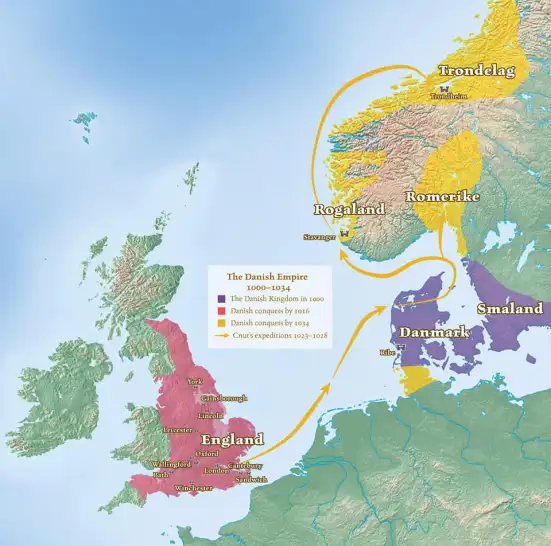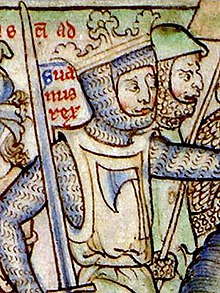Nordic Discovery, Viking
The Life and Death of Sweyn Forkbeard and His Viking Empire
Sweyn I, also known as Sweyn Tiugeskaeg, meaning “Forkbeard”, was a Viking chieftain who ruled over Denmark, Norway and England. He was nicknamed “Forkbeard” because of his long and spiky beard. Although Sweyn had ruled Denmark and Norway for decades, he only captured and ruled England for about a month before he died. In fact, although he was crowned King of England, he did not live long enough until his coronation.
After his death, Sweyn’s empire gradually declined. While one of his sons inherited Denmark, Norway and England go back to the time when the rulers were indigenous. However, Sweyn’s territory, which was fully recovered by his other son Cnut the Great. The empire of Sweyn Forkbeard and his son is often referred to by historians today as the North Sea Empire or the Anglo–Scandinavian Empire.
Sweyn I is believed to have been born around 960 AD. His father is Harald I, also known as Harald Bluetooth, and his mother’s identity is unknown. Harald was a member of House Gorm, the Danish dynasty founded by Elder Gorm. This royal family resides in the town of Jelling, in the northern part of the Jutland Peninsula, Denmark. Under Harald’s rule, Denmark was united for the first time as one. Although Harald is credited with unifying the country, the real campaign began under his predecessor. In addition, Harald also conquered Norway and converted to Catholicism, resulting in the introduction of Catholicism into Norway and Denmark.
SWEYN FORKBEARD RIGHT AGAINST HARALD BLUETOOTH
Not much is known about Sweyn’s childhood. He appears in historical records as a sadist. According to many medieval historians, Sweyn’s rebellion against his father took place in the last years of Harald’s life, around 987 AD. The German chronicler, Adam of Bremen, attributes Sweyn’s rebellion to opposition to the Catholicization of Denmark. However, this chronicler’s claim is somewhat questionable, as there is no indication that Sweyn was a pagan. Alternatively, Adam may have held a grudge against this Danish king, as he was against the Hamburg-Bremen church.
The story of Sweyn’s rebellion is recorded by Historian Snorri Sturluson in the “Heimskringla” (Chronicles of the Norwegian Kings). According to this work, Sweyn asked his father to cut part of Denmark for him. Harald had no intention of dividing his kingdom, so he refused his son’s request. So he gathered his men, and told his father that he was going to plunder elsewhere, in fact preparing to rebel. When the preparations were complete, he attacked his father. Harald won the battle, because he had a larger army, but was mortally wounded and died not long after.
According to another story, Harald was defeated, had to flee to the Wends (the Slavic community settled in Germany) where he died of his wounds. As for Sweyn, he withdrew from the battlefield and when he heard the news of his father’s death, he proclaimed himself king. However, this new king was captured by Sigvaldi, the Jomsviking leader. Sigvaldi forced Sweyn to make peace with the Wends before releasing him back to Denmark.
In the “Heimskringla” it is recorded that Sweyn married the daughter of Burizleif, King of the Wends, Gunhild, and had two sons, Harald and Cnut. Although Burizleif is only a legendary figure, many people believe that he could be a real person. Sweyn then married Sigrid the Arrogant, widow of the King of Sweden, Eric the Victorious. It is further documented that he married Sigrid after Gunhild’s death. There are other documents that say that he refused Gunhild and married Sigrid. As a result, Gunhild returned to the Wends, and was only brought back to Denmark by his son after Sweyn’s death.
LOOKING FOR THE UK
Not long after becoming king of Denmark, Sweyn set his eyes on England. In the late 8th century, Great Britain was a prey for Viking raids, most of whom chose large monasteries that were loosely guarded. The next century, the Vikings began to settle on the island. At the end of the 9th century AD, a large area of Great Britain was under Viking control. That area was called Danelaw, and the Vikings ruled it until the mid-10th century.
In 954, Eric Bloodaxe, the last Viking King of the Kingdom of Northumbria, was banished, marking the end of the Danelaw region. For the next few decades, England was ruled by native kings. In 978, Aethelred II became the new king of England. This event occurred about a decade before Sweyn took power.
SUCCESSFUL UK UNDER SWEYN FORKBEARD
During the 990s, Aethelred remained on the English throne, and he ruled until 1016. This was when the “second Viking Age” began. Unlike the 9th and 10th century Vikings, at first, Sweyn was not interested in conquering England. Instead, he preferred raids.
Unlike the 8th-century Vikings, Sweyn’s raids were carried out on a large scale. He was not aiming for monasteries but for territories. For fear of Viking destruction, the British accepted to pay fees in exchange for peace. This part of the fee is called the Danegeld, or protection fee. For example, in 991, the Vikings were paid up to 4,500 kilograms of pure silver in exchange for peace in England.
SWEYN FORKBEARD RATED LONDON
The situation was not very good, especially in the North of England, where the Vikings continued to rage. According to the Anglo-Saxon Chronicle, in 994, Sweyn raided London with London as the ultimate goal. This manuscript notes that:
“This year it was Anlaf (Olaf Trygvasson, King of Norway) and Sweyn to attack London, on the Nativity of Mary (September 8), on 490 ships. They laid siege to the city, and intended to burn London; but they have done more harm and evil than others have done to them. Our Lady always saves these inhabitants, and guides them from their enemies.”
Although the Vikings failed to attack London, they did not necessarily return home immediately. Instead, they attacked other parts of England:
“Then they roamed, and committed the most atrocities an army could, in burning, pillaging and slaughtering, not only on the Essex coast, but also in Kent, Sussex and Hampshire. Then they took all the horses and left.”
For some reason, Aethelred refused to move to fight the Vikings. Instead, he chose to pay them in exchange for peace as in the past:
“The king and council settled by sending them protection fees to ask them to stop looting. They agree to the condition; the army then moved to Southampton, and repaired its wintering there; where they are served by the people of the West Saxon Kingdom.” (The court paid them the equivalent of £16,000 today.)
In exchange, Olaf decided to convert to Catholicism and vowed not to return to England to plunder. According to the Anglo-Saxon Chronicle, Olaf kept his oath. According to the Chronicle, Olaf took the lead in 994, Sweyn was a supporting role. Although Olaf had kept his vow not to return to England to pillage, Sweyn had no such intention. According to many records, while Sweyn was sweeping England, Eirik the Conqueror seized the opportunity to take over Denmark. And in the meantime, the King of Sweden died and Sweyn took the opportunity to sit on the throne.
Under the leadership of Sweyn Forkbeard, the Vikings continued to sweep England in the following years, and in 1003 he launched an all-out assault on the island. The king of Denmark decided to attack on behalf of himself to avenge the events that happened a year ago. That spring, Aethelred married Emma, sister of Richard II, Duke of Normandy. An alliance was formed between England and Normandy, providing support for Aethelred to rise up against the Vikings.
According to the Anglo-Saxon Chronicle, in 1002 Aethelred received word that the Danes in England planned to assassinate him in order to gain power. As a preemptive strike, he launched a surprise attack by massacring all Danes in England on the Feast of Saint Brice (that is, November 13).
According to various records, one of the Danes killed was Gunhild, Sweyn’s sister. If this is true, it will increase the enmity between Sweyn England. Anyway, in 1003, Sweyn decided to attack England:
Saint BRICE’s carnage and SWEYN’s revenge
“When Sweyn realized the British were being negligent, he made them pay; he led his army to attack Wilton, looting and setting the whole village on fire. He then attacked Sarum; at last he returned to the sea, where he knew a boat was waiting for him.”
SWEYN AND THE CONQUER OF NORWAY AND ENGLAND
While his Viking army swept England, Sweyn proceeded to conquer Norway, which was ruled by his former comrade Olaf Trygvasson. Sweyn forged an alliance with the Swedes and the Counts of Lade, attacking Olaf simultaneously. At the Battle of Svolder in 1000, the Norwegians were defeated, and Sweyn became the new ruler of Norway. And the fate of England will also fall into the hands of the Vikings in Denmark after a few years.
In 1013, Sweyn launched another sweep on English soil, which had been unfinished since 1004. This sweep was different from the previous sweeps, for he decided to attack with all his might to conquer England. As the Anglo-Saxon Chronicle notes:
“Before August, King Sweyn and his army advanced to Sandwich, and soon spread from East Anglia to Humber-mouth, and then to Trent, and then to Gainsborough. Then submit to Earl Utred, and all the people of Northumbria, and then the people of Lindsey, and then all the people of the five Boroughs, and soon all this army will advance north of Watling-street.”
To secure the loyalty of the subdued English nobles, the Vikings took their relatives hostage. The hostages were left to Sweyn’s son Cnut, who guarded Gainsborough, the new Viking facility. This Danish king headed south, continuing his conquest of the island. When Sweyn arrived in London, he realized that the people would not submit, so he decided to continue on to Bath, where he received the submission of the Anglo lords before returning to Gainsborough. At the moment, London is under siege. Aethelred was forced into exile and took refuge in Normandy by his brother-in-law. This exiled king remained there until Sweyn’s death.
SWEYN FORKBEARD’S SURPRISE DEATH AND THE DECEMBER OF THE IMPLEMENT
In late 1013, Sweyn was at the height of his power and ruled Norway, Denmark, and England. But in February of the following year, he passed away again. According to the Anglo-Saxon Chronicle, in 1014, “That year King Sweyn died on the Feast of the Presentation (February 2).” Interestingly, the Heimskringla provides more details about Sweyn’s death: “it occurred when King Sweyn died suddenly during the night in his bed; and the English say that Saint Edmund killed him, the same way Mercury killed Julian the Apostate.”
As a result, after Sweyn’s sudden death, the empire he created fell apart almost immediately. In England, Aethelred returned from exile and ruled until his death in 1016. Likewise, the throne of Norway passed to the natives. However, Sweyn’s son, Cnut, would later revive his father’s empire. Cnut ruled England much longer than his father, giving him more time to impress the British with what he had done. His deeds were recorded by English writers of the time, and hence, he is known today as ‘Cnut the Great’. Sweyn, on the other hand, ruled England only for about five weeks, and had no time to prove himself a capable ruler.

















